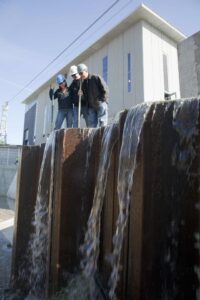 A new $25 million hydroelectric power plant on the north bank of the Kansas River is expected to start producing electricity as early as Friday, about a month ahead of schedule.
A new $25 million hydroelectric power plant on the north bank of the Kansas River is expected to start producing electricity as early as Friday, about a month ahead of schedule.
The new skyline-altering project also is expected to produce something else: a rain dance or two.
Leaders with the Bowersock Mills & Power Co. said the project just north of the Kansas River bridges in downtown Lawrence has progressed remarkably smoothly, in part because the summer’s drought allowed construction crews to work at a quick pace.
But now as the plant is ready to produce electricity, water levels in the Kansas River are so low that the plant is able to produce electricity only at a fraction of its designed capacity.
“I felt bad when I was the only one in the state this summer cheering on a drought,” said Sarah Hill-Nelson, an owner and operator of the Bowersock company. “We got lucky that it was dry when we needed it to be dry. But now we’re cheering for rain, and we’ll really see how lucky we are.”
Construction crews on Wednesday began removing a coffer dam that was protecting the plant from the Kansas River. Hill-Nelson predicted that by Wednesday night the base of the plant, where the facility’s four turbines are located, will be inundated with water, likely to never be seen again by the motorists who drive past the plant each day on the Kansas River bridge.
“We hope we do not have to see the front of that plant again for many, many years,” Hill-Nelson said.
Over the next 10 days or so, the company will begin inflating a new rubber bladder that has been installed on the top of the Bowersock Dam. The bladder, which increases the height of the dam, will allow the mill pond upstream of the power plant to start rising in elevation. But Hill-Nelson said the process will have to be done slowly to ensure that other communities, such as Kansas City, that depend on the Kansas River for water supplies continue to have adequate flows.
Plant operators are scheduled to begin “energizing” the four turbines on Friday, meaning they’ll start testing the turbines’ ability to produce electricity.
The plant, which can generate enough electricity to power about 5,400 homes, won’t be ready to operate at full capacity for about four weeks.
But it’s likely Mother Nature won’t be cooperating by then. Hill-Nelson said the current river flows aren’t enough to operate even one of the plant’s four turbines at full capacity. Bowersock operators would like to see the river start flowing at 3,400 cubic feet per second, while 5,400 cubic feet per second would be ideal. Currently, the river is flowing at about 700 cubic feet per second.
“We just need a nice, good wet winter,” Hill-Nelson said.
The low water levels, however, aren’t putting the new project at financial risk, Hill-Nelson said. She said lenders required the company to show that it could withstand three straight years of drought conditions.
“We’ll be all right,” Hill-Nelson said. “If it doesn’t rain between now and the next three years, there will be a whole lot of people in Kansas in a lot of trouble.”
The dry weather was not doing much to limit the excitement of Bowersock officials on Wednesday. Stephen Hill, an owner of the plant and Hill-Nelson’s father, has been working on the project for more than five years, noting the plant took a combination of 17 federal, state and local permits before it could be built.
The plant — which has a contract to sell its electricity to the Kansas City, Kan., Board of Public Utilities — uses a dam that was built in the late 1800s by Stephen Hill’s great-grandfather, J.D. Bowersock, one of the city’s first great industrialists.
The dam has been used to power Bowersock’s original power plant on the south bank of the Kansas River for more than a century. The south plant remains in operation.
On Wednesday, Stephen Hill stood on the Kansas River bridge while he watched his daughter use a shovel to remove the final pieces of soil blocking the flow of water to the plant.
“They didn’t tell me I would have to get in the mud, and I had my office shoes on,” Hill, who is a financial adviser in Lawrence, said of his decision to stay on the bridge.
But he said the view from up high was good.
“It is a historic moment,” Hill said. “It has been a long time coming.”
Hill-Nelson said the view looking up was special too.
“It got pretty emotional looking up there at my dad,” Hill-Nelson said. “It was a moment you wanted to imprint in your mind so you never forget it. It was a momentous occasion for us.”
Hill-Nelson said the company hopes to have a community open house of the plant sometime in December. It plans to have a formal ribbon cutting in the spring.
